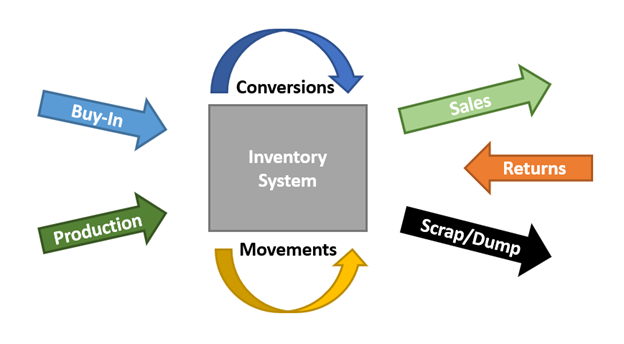
Which Type of Automated Replenishment Should You be Using?
September 20, 2022
4 Types of Business Analytics Growers Need to Know
October 18, 2022One of the most important components of a grower’s operational management is managing the inventory they create and sell. Inventory, as one of my college professors, said is ‘frozen cash’. So, its management and visibility are crucial for the best operational decisions.
Grower operational software must support several types of inventory transactions to meet all a grower’s situational needs.
1) Creation or Addition to inventory
Production
Growers produce product by combining necessary raw materials such as soil, containers, and plant inputs to create a new inventory transaction. Recording production in a system with details such as item type, quantity, date, location, and costs to name a few.
Buy-In
Sometimes growers buy and then re-sell without changing some items. So, it is crucial for the inventory system to allow the receipt of goods into the inventory that can then be resold to the grower customers. The grower system should allow the receipt and cost of goods, as well as the quantity and item details.
Returns
No matter how good the plants are sometimes we must take inventory returns. Sometimes the return is a viable plant and can be added back into inventory and then resold. Other times the return is not viable and must be scrapped or written off and the customer account credited.
2) Removals From Inventory
Sales
Sales are the removals from inventory that yield revenue for the grower. They subtract from grower inventory and, in some cases, record the associated costs (COGS). The removal from inventory should decrement the total quantity and value of the items as well as indicate the freeing up of space where the plants were taken from.
Scraps or Dumps
Scraps or dumps are cases where the plant is diseased or damaged and was no longer viable and must be thrown away and written off. Sometimes it’s mechanical damage like being run over by a tractor (yes that has actually happened). When an item is scrapped is must be recorded as the removal from inventory should decrement the total quantity and value of the items. Some systems track scrap separately to accumulate the total value of scrap as a grower quality metric or analytics.
3) Other Changes to Inventory
Item Movements
For growers that need or desire location tracking, movements are a key inventory transaction. Recoding location accurately, helps your operational staff find things faster and saves you labor in the long run. Arguably, any plant movements add cost to items but sometimes cannot be avoided or are planned as in the case of spacing some types of plants. Plant movement transactions typically decrement the quantity and item form one location and add it to the destination location.
Conversions
Some growers, responding to sales situations or normal plant maturity, will convert one finished item to another. Say, for some shrubs repotting from a 1Gal container to a 2.5Gal container, consumes one finished good item and creates another higher value finished good item. For many shrubs and trees this a part of normal production.
For our greenhouse growers there is some of those types of changes, sometimes called ‘bump ups’. Other times a grower may take some unsold annuals and create a combo item by re-potting them together in a larger container. Sometimes this can yield new revenue for as yet unsold items.
In these types of cases, the grower needs a system that will record the consumption (reduction in inventory) and then record the production (addition to inventory) of the new item.

Typical Inventory Transactions
Copyright Advanced Grower Solutions
Conclusion
Managing a very dynamic inventory like live plants is difficult. A good software inventory system supporting all the transaction types you need is crucial to your operational success.
The rewards of a good inventory system are
- Ability to know what you have
- Ability to know where it is stored
- Ability to track what is ready to sell
- Ability to track operational efficiencies and costs
AGS has software that can help you manage your inventory and improve your operation. Contact us today for a consultation and demo.





